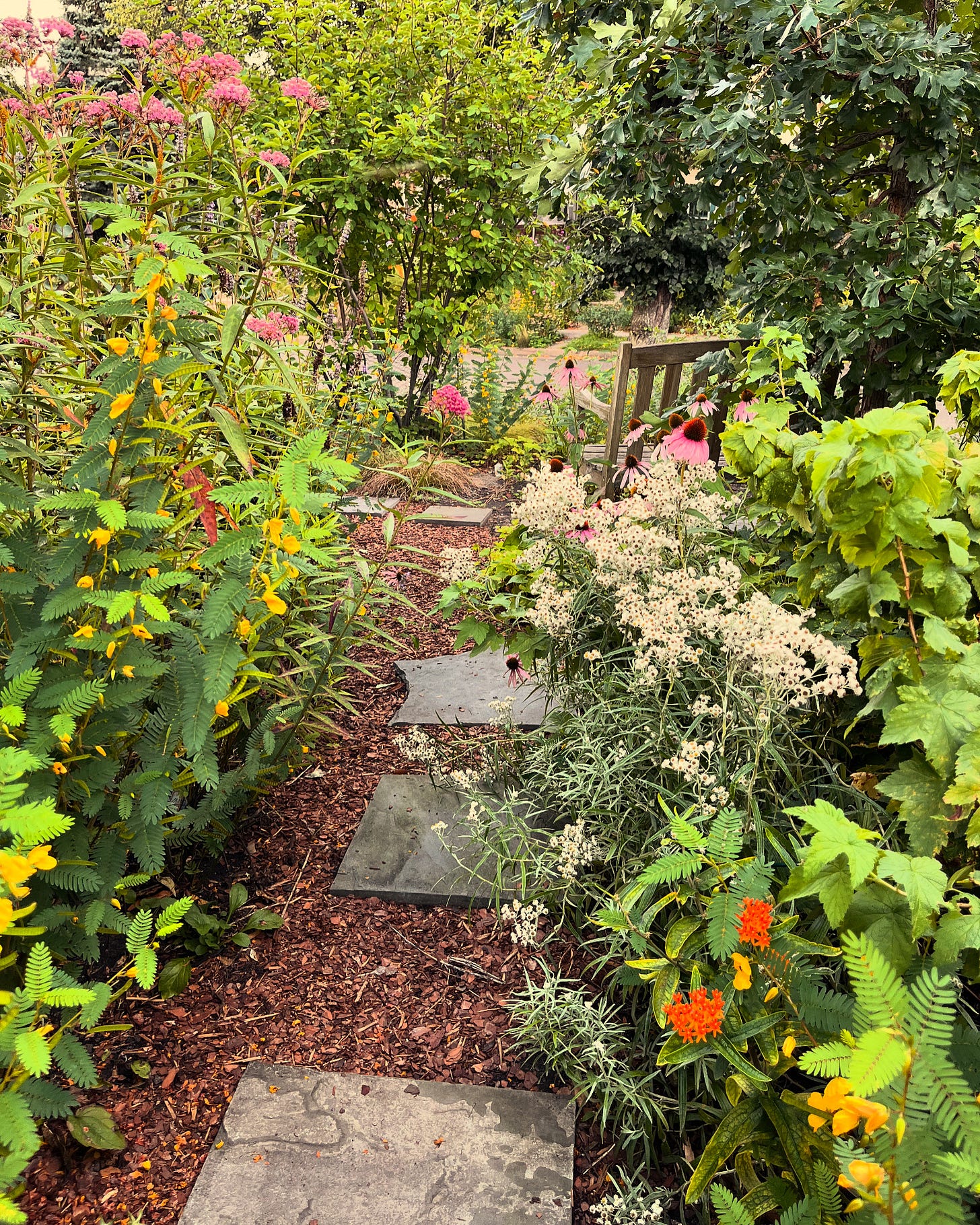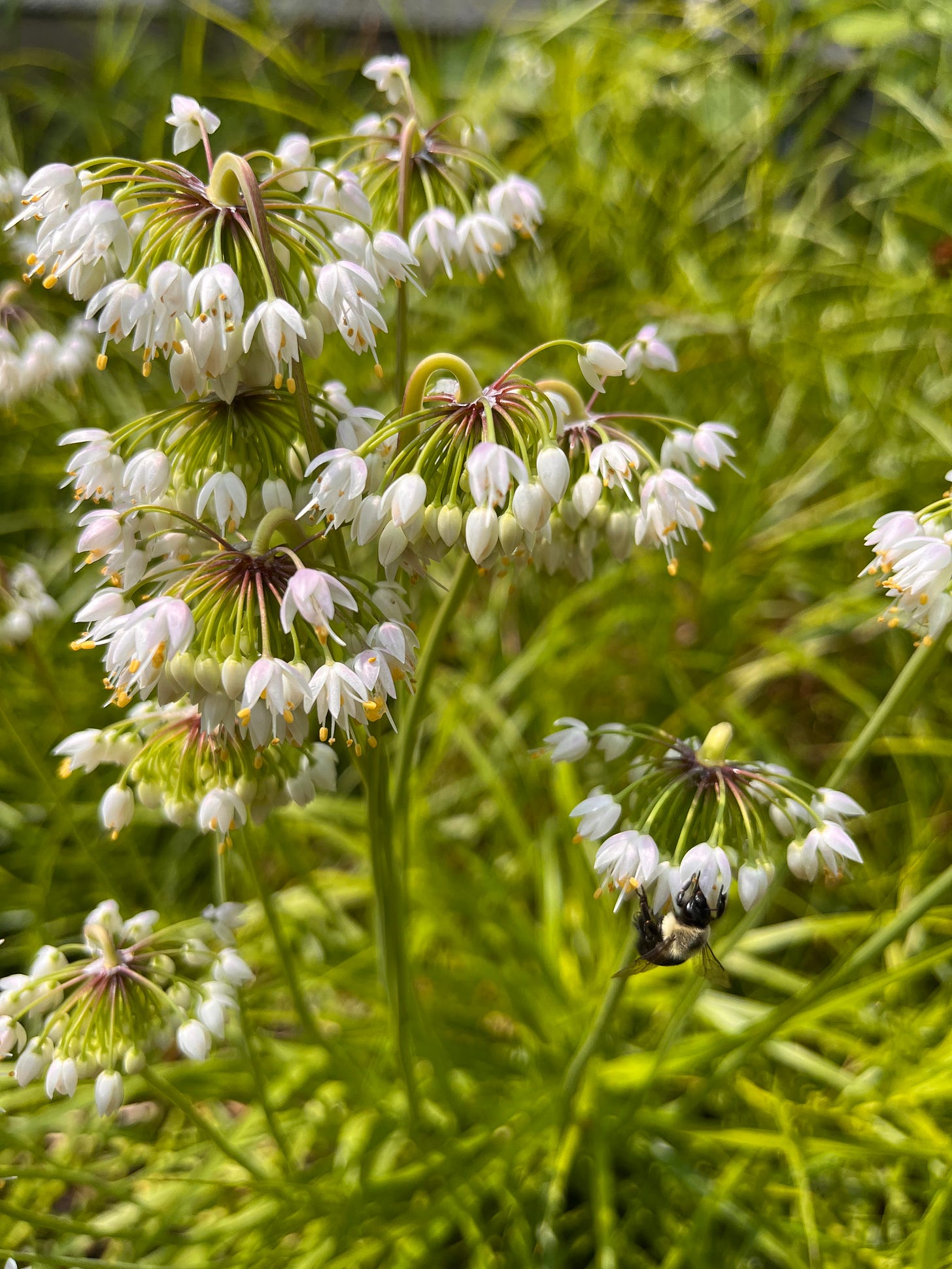A living incantation, a sensory poem, a summer day I can touch — this is my wild garden.
Through a litany of petal and leaf I walk. Breathing an incense of herbs that signals each shift in season: bloodroot, prairie smoke, wood poppy, trillium. Purple prairie clover, butterfly weed, wild bergamot. Rattlesnake master, blazing star, goldenrod, aster, I name them in turn.
Here I made a home for them, poured water on their roots through years of drought, like the mother I am not … yet, also am. For what else is a garden but a living community to care for? I am a mother to a garden, daughter to green solace, witness to the wildflowers’ every unfolding.
From sunlight, soil and rain the plants fashion themselves. They alone of all beings on Earth possess this alchemical gift. And their generosity is as measureless as their generative spirit — a purely wild and holy genius designed to sustain the life of an entire planet.
August is a time of first harvests. Sparrows raid papery seed packets from our hop-hornbeam tree, while goldfinches filch Agastache seeds. Gray squirrels keep watch, audibly gnawing golf-ball husks of black walnuts. To the atonal buzzing of dog day cicadas, milkweed’s torpedo pods swell, bunches of black chokeberries sweeten on the bush, columbine’s dried beaks spill seeds over the ground.
At midsummer in the garden, as I stole a last serviceberry from a scolding gray catbird, I imagined I was swallowing the sun, the rain and the seeds of life itself. Now, golden slashes of sunlight conjure browning hazelnuts, green acorns, white snowberries, black currants, deep-blue berries of Solomon’s Seal and glowing red bunches of highbush cranberries. Scenting the air is the almost entirely poisonous-to-humans Mayapple, its ripe yellow fruits sweetly redolent of pineapple-pear-melon. At eye level outside the windows bob huge flower-heads peppered with wild bees.
After a rain is when the garden’s life force visibly pulses. I sit among the blooms plant-bathing, noting the way this chaos of flowers looms in my direction — a green tide of life ready to break its bounds and swallow the pathway whole, and me with it.
These wild beings seem fully capable of taking over the entire world, one yard at a time, and who are we to hold them back?
Plants, writes Robin Wall Kimmerer, are our oldest teachers. Some things my plant teachers suggest that I learn to do: Create profusely. Thrive in community. Adapt when needed. Feed whoever comes. Share your gifts. Do something that matters.
My something has been making this garden, a home for what E.O. Wilson called the little things that run the world: insects, insects, insects, and the life they give rise to.
But it is also a gift to my own dryad self; who, ever and always, longs to protect and heal what has been hurt.
The garden feels like a song the land wants to sing. This is what gives it meaning, ties it to place. Its green ancestors are old upon this continent, deeply rooted in North America for thousands of years.
Generation upon generation, billions of caterpillars fed upon these oaks and milkweeds, violets and viburnums, transforming themselves into millennia of moths and butterflies.
Bison turned grasses like these bluestems and gramas into blood and bone, dispersing thousands of their seeds as they roamed the savannas and prairies.
Birds raised young and fueled transcontinental flights using the insects, fruits and seeds brought into being by vast native plant communities echoed in this tiny, human-shaped garden.
Here I can witness their descendants keeping faithfully their sacred promise to the Earth: To make abundant food and medicine, offered freely to other beings. To grow in tightly knit relationships with other species and natural cycles. To create more life, and more, and more, in splendid profusion.
Even in this little urban garden I can glimpse the exquisite interweaving of the natural world — this complex-yet-fraying web of relationships that form the foundations of all life on this planet. Sun to leaf. Leaf to insect. Pollen to bee. Soil to seed.
A garden such as this is one answer to the question: How do we belong to a place? How do we put into action our love for what we cannot bear to lose?
We can belong to a place by paying attention to who lives there and caring for them. As we do, we begin to knit the ground of our inner landscapes to the living world around us, upending the devastating cultural myth of our species’ separation. We open ourselves to moments of profound wonder and connection. And perhaps we no longer feel alone in the universe, because we are not.
For the whole world was made to be a garden of belonging. Yes, there are now so many losses that our heartbreak may not ever leave us … yet, isn’t that how we know we are alive in a mortal world?
Changing angles of sunlight are the calendar of the sky, as blooming is the calendar of the land. Each season has its own timeless quality, and seems endless … until a key thing changes.
In the past few days has crept over me a sense of summer senescing, crisping at the edges, shifting into early autumn.
Not even two weeks ago I watched entranced as a dozen chimney swifts high overhead danced an intricate pattern of interlocking circles, like a ring quilt in motion. It had a ritual quality that put me in the mind of cycles — matings and migrations, the circling of the seasons, the turning of constellations in the night sky, far beyond the reach of our screens.
All summer long I was companioned by these swifts hawking overhead, casting their flickering blessings over the rushing Earth. Now, without me quite knowing when, they have vanished — leaving me three steps behind, unanchored in the change.
We never know when it will be the last time we see anyone or experience anything, yet this loss always comes as a surprise.
Perhaps the conclave of the swifts marked the beginning of their 4,000-mile journey to the upper Amazon basin, a continent away.
Perhaps, with a last great wheeling, witnessed by one wonderstruck human, they were saying goodbye.
More …
If the idea of making space for wildlife speaks to you, I recommend watching “Let Your Garden Grow Wild,” a TED talk by Rebecca McMackin, former director of horticulture at Brooklyn Bridge Park.








Dear Carmine, even in the short time that I have been reading your work the writing has deepened and taken on a charge and charm, a delicacy of touch. I hope you yourself are thrilled by the sound of it (even if you won't admit to that out loud :-)). Truly an end in itself, wherever it takes you next.
Carmine, this is stunning. Robert Hass has this line in his poem where he says, “Longing, we say, because desire is full of endless distances.” Your writing brings me closer to a yearning that feels complete in itself. Thank you for your words.